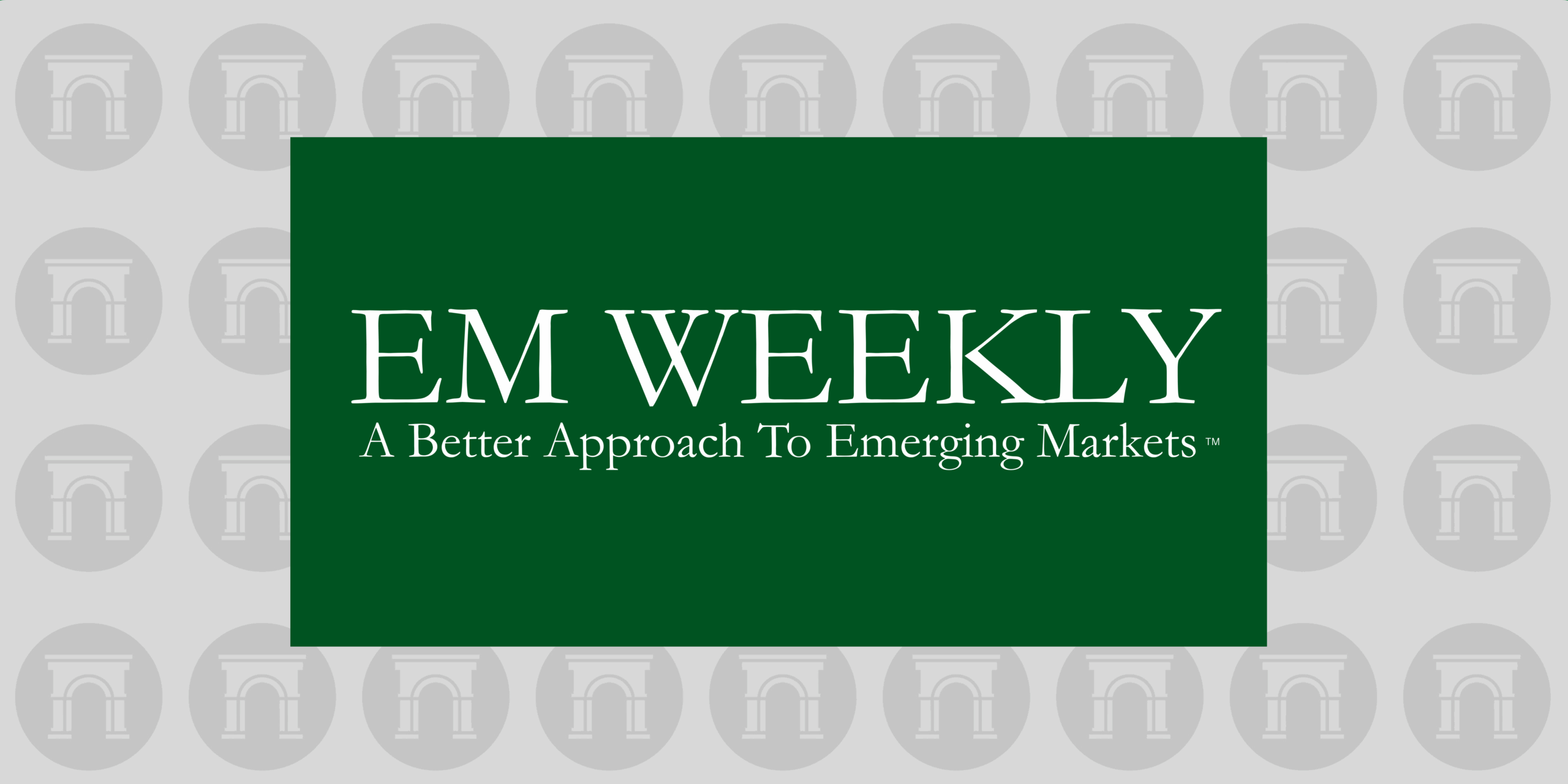Contents
Market Overview
Macro Update
This week saw a historic U.S. strike on Iran’s nuclear facilities, a symbolic retaliation by Iran against a U.S. military base in Qatar, and an abrupt but fragile ceasefire between Israel and Iran. This unprecedented string of events sent oil prices down and further pressured the dollar. It also left critical questions unanswered, most importantly, the extent of damage inflicted on Iran’s nuclear program by Israel and the U.S. during the brief conflict.
Initial assessments are highly contradictory. U.S. President Donald Trump, echoed by Israeli Prime Minister Benjamin Netanyahu, has claimed that Iran’s nuclear sites and capabilities were “obliterated” and called for a return to negotiations with the Islamic Republic’s leadership. However, European officials and even some of President Trump’s own intelligence agencies signaled that Iran’s enriched uranium stockpile was moved prior to the attacks and is largely intact.
Despite this inconclusive outcome and lingering uncertainty about the Middle East’s geopolitical outlook, markets have moved on. Counterintuitively, oil prices collapsed after Iran’s ballistic missiles were intercepted and did not cause any damage to the U.S. base in Qatar – reflecting bets that the symbolic nature of Tehran’s response marked its de-facto capitulation.
That meant oil gave back all its “escalation premium,” returning to pre-June 13th levels of around $68 per barrel for Brent and $66 for WTI – nearly 10% above the recent lows in early May. Equity markets finished the week positively, reflecting the de-escalation in the Middle East and renewed trade optimism. The “stocks higher – treasuries lower” pattern held this week, with UST yields trending 5-6bps lower, to around 4.28% and 4.84% on the 10Y and 30Y, respectively. The USD resumed its march lower, with the DXY touching 97 for the first time since 2022 and EUR/USD breaking comfortably above the 1.15 level to around 1.17. Gold also sold off slightly to near $3,275 per oz., but remains close to its recent multi-year highs.
With the Iran-Israel ceasefire in his pocket, President Trump attended the NATO Summit in the Hague, where the Alliance’s members (except for Spain and Slovakia) agreed on a historic increase in their annual defense spending target to 5.0% of GDP by 2035, from 2.0% previously. This was split between 3.50% on direct military spending and 1.50% on supporting infrastructure, technology, etc. Over the medium-term, the decision appears set to have significant impact on European and global security, as well as macroeconomic, fiscal and trade dynamics.
On the other side of the Atlantic, Fed Chair Jerome Powell gave his semiannual congressional testimony, reiterating the Fed’s “wait and see” approach in the context of a resilient labor market and overall economy, and among indications that a pickup in inflation “could show up in 3Q.” His view is at odds with the Trump Administration, which has denied the possibility that current trade and immigration policies could be inflationary. President Trump intensified pressure on Chair Powell to cuts rates, calling him “terrible,” and President Trump suggested he may name the next Fed Chair early. These unprecedented executive branch attacks on the Federal Reserve’s traditional independence and the potential appointment of a “shadow Chair” eight months ahead of customary schedule could begin to undermine Fed policy credibility and could have far-reaching market consequences.
On Capitol Hill, U.S. lawmakers continued to scramble on reconciling the House and Senate versions of the “Big Beautiful Bill”. It remains unclear if the July 4th deadline set by the White House can be met or if deliberations will drag on.
Meanwhile, U.S. Treasury Secretary Scott Bessent gave optimistic projections around signing favorable trade agreements with the majority of the main U.S. partners by early September. Despite a lack of clarity on the timeframe and the substance of those agreements, the market welcomed Secretary Bessent’s comments.
On the macro data front, PMI data released this week painted a mixed picture across the major global economies. The preliminary June readings in the U.S. came in stronger than expected (52.8 vs. 52.2 on the composite) but slightly lower than the 53 reported in May. The Euro area composite PMI moderately missed expectations (50.2 vs. 50.4) but remained stable from May, while Germany’s national one outperformed and France’s underperformed. The UK’s 50.7 reading improved from last month’s 50.3 and was slightly above expectations.
Other U.S. economic data had a weakening tone, with the June Conference Board’s consumer confidence index falling to 93, from a revised 98.4 in May and consensus expecting an improvement to 99.8. Purchases of new homes fell 13.7% (vs. -6.7% expected) to a 623,000 annualized rate in May, a seven-month low, due to affordability constraints despite sales incentives. The merchandise-trade deficit widened 11.1% to $96.6 billion in May, exceeding economists’ estimates, due to a 5.2% drop in exports and little change in imports. Despite a decline in exports, orders for durable goods jumped 16.4% in May (vs. 8.5% expected and a decline of 6.6% in April), driven by a surge in commercial aircraft orders, and core capital goods shipments climbed 0.5%.
In terms of closely watched labor market dynamics, initial jobless claims surprised to the downside this week (236,000 vs. 243,000). However, continuing claims jumped to the highest level since November 2021 (1,974,000 vs. 1,950,000 consensus), suggesting that work-seekers are having an increasingly hard time finding jobs. Meanwhile, the third estimate of 1Q 2025 annualized GDP was revised sharply lower to -0.5% quarter-over-quarter, from -0.2% previously, mainly on the back of significantly lower consumer spending on services.
The May personal income and outlays report showed a stagflationary picture, with core inflation rising more than expected and incomes falling due to lower transfer payments. Consumers appear to be becoming more discerning in their spending, pulling back on discretionary services and interest-sensitive categories, with personal spending declining 0.1% (vs. +0.1 expected) and real consumer spending declining 0.3% (vs. flat expectations), the most since the start of the year.
The Core PCE Price Index, the Federal Reserve’s favorite inflation measure, rose more than expected in May: 0.2% month-over-month (vs. 0.1%) and 2.7% year-over-year (vs. 2.6%) and accelerated vs. April’s readings of 0.1% and 2.6%, respectively. To close the week, the final June reading of the University of Michigan’s Index of Consumer Sentiment was revised higher to 60.7, from 60.5 in the preliminary reading, marking an improvement from 52.2 in May.
Elsewhere, Central Banks in Hungary and Thailand held rates unchanged at 6.50% and 1.75%, respectively, in line with market expectations. Banxico, Mexico’s Central Bank, cut its benchmark rate by 50bps to 8.0%, but removed guidance on the magnitude of subsequent cuts.
EM Credit Update
EM hard currency sovereign debt posted a strong 1.0% gain for the week, with high-yield (+1.3%) outperforming the investment-grade segment (+0.7%). At the index level, spreads were 2bps tighter, driven by high-yield spreads that were 9bps tighter, while investment-grade widened by 4bps.
Africa (+1.8%) led regional performance again, but all EM regions performed well across the board. Ukraine and Lebanon led gains in the distressed space amid a sense of geopolitical de-escalation, while Ecuador, Argentina, and Egypt dominated returns in the performing high-yield space as markets were in a clear “risk on” mood. Suriname was the underperformer this week on some political uncertainty, but this comes on the back of strong returns in recent weeks.
EM local currency sovereign debt gained 1.6% this week, amid a weaker USD, reaffirming its outstanding YTD performance of +12.0%.
EM corporate debt underperformed sovereigns this week, posting a 0.6% return at the index level, with investment-grade and high-yield contributing evenly; spreads were 6bps wider for the overall index and 8bps and 5bps for investment-grade and high-yield, respectively.
Primary market activity in EM was on fire this week, with 59 deals pricing across all regions, eight of which were sovereign: Mexico, Slovenia, Chile, Kazakhstan, Türkiye, Peru, Uruguay, and Korea all took advantage of lower UST yields and improved market sentiment to tap global markets.
The Week Ahead
The week ahead features the ECB’s annual forum in Sintra, Portugal through July 2nd, where Christine Lagarde, the bank’s President, will deliver a keynote speech. Other speakers at the Sintra forum include Fed Chair Powell, Bank of England Governor Andrew Bailey, and Bank of Japan Governor Kazuo Ueda. Beyond monetary policy talk, markets will be processing an abundance of macro data, including the U.S. jobs report. Early estimates show economists expect fewer gains than Mays 139,000 jobs, along with a rise in unemployment. Other U.S. data releases during the short week ahead of the July 4th holiday include ISM Manufacturing, job openings, light vehicle sales, initial jobless claims, factory orders, and trade. June PMI will be reported by China, the eurozone, France, Germany, India, Italy, Japan, Mexico, Netherlands, UK, and Canada. Germany, Italy, Kenya, Poland, the eurozone, Indonesia, Netherlands, South Korea, Switzerland, Türkiye and the Philippines will publish June CPI numbers. Rate decisions are due from the Central Banks in the Dominican Republic and Poland, and the UK reports final 1Q GDP.
Fixed Income
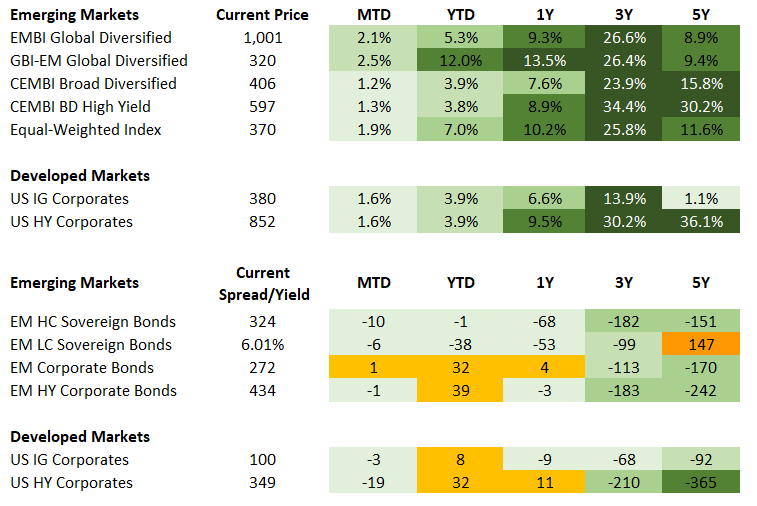
Equities
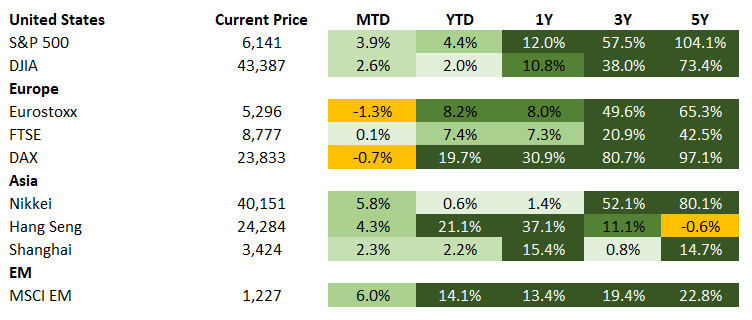
Commodities

Source for data tables: Bloomberg, JPMorgan, Gramercy. EM Fixed Income is represented by the following JPMorgan Indicies: EMBI Global, GBI-EM Global Diversified, CEMBI Broad Diversified and CEMBI Broad High Yield. DM Fixed Income is represented by the JPMorgan JULI Total Return Index and Domestic High Yield Index. Fixed Income, Equity and Commodity data is as of June 27, 2025 (mid-day).
Highlights
Gas Flows to Egypt Resume as Israel-Iran Truce Holds
Event: Israel restored gas production at its largest field, Leviathan, after brief cessation amid the so-called 12-day Israel-Iran War. Later in the week, Egypt raised $1 billion in a 3-year private placement sukuk to Kuwait Finance House.
Gramercy Comment: Egypt’s external position has been under pressure since the escalation of regional tensions in October 2023. The latest attacks threatened to further exacerbate existing fragilities – potentially causing higher gas prices and import constraints, pressure on tourism remittances and Suez Canal receipts, and capital outflows. However, the swift de-escalation of the war, combined with multilateral and regional support, provides a backstop for the credit. This was reflected in the relatively muted market reaction in Egyptian bonds this week. We expect an eventual IMF disbursement upon completion of the ongoing fifth review, with possible adjustments to some targets. We also expect acknowledgement of solid progress in fiscal trends and inflation, as well as continued pressure to accelerate reforms to reduce the state’s footprint in the economy. Given the still fluid and uncertain external backdrop, and Mays reversal of an otherwise impressive decline in inflation, we expect the Central Bank of Egypt to adopt a cautious approach at its upcoming meeting on July 10th.
More Deadly Protests in Kenya Challenge Ruto Administration
Event: Eight people died and at least 400 were injured in clashes across Kenya between security forces and protesters. The unrest marks the first anniversary of deadly anti-government demonstrations that erupted in June 2024, when the Administration of President William Ruto attempted to introduce tax increases as a tool for fiscal adjustment under the country’s IMF program.
Gramercy Comment: Since the failed tax increase attempt last year, Kenyan authorities have been struggling with finding alternative avenues to reduce the government’s budget deficit, seeking a balancing act between supporting growth and optimizing public spending. Other thorny issues, such as government corruption, mismanagement of public resources, and police brutality have also fueled lingering social discontent. Against this backdrop, real GDP growth in East Africa’s biggest economy – and home to nearly 60 million people – slowed to 4.7% year-over-year in 2024, the slowest pace since the Covid-19 pandemic.
President Ruto’s Administration has been working on various reform initiatives to stimulate growth, address social concerns and decrease unemployment, especially among the young. It’s also been tackling difficult fiscal consolidation, which has cost the Administration valuable political capital. Regained access to global capital markets and fund inflows from Gulf Cooperation Council sources have alleviated near-term liquidity and credit risks, but medium-term structural challenges remain significant, as illustrated by the fresh wave of anti-government protests.
Cote d’Ivoire Receives IMF Disbursement on Strong Program Performance
Event: The IMF Board completed reviews of Cote d’Ivoire three facilities with the Fund and disbursed $758 million to the country. The government met all performance criteria and continued to make solid progress on structural benchmarks and climate-financing reforms. The IMF forecasts 2025 growth at 6.3%, while the current account and fiscal deficits are expected to narrow to 3.6% of GDP and 3.0% of GDP, respectively. Domestic revenue mobilization and structural reform efforts, with respect to governance and financial integrity, human capital development, and reduction of the informal sector, remain key areas of focus.
Gramercy Comment: The country’s continued solid progress under its IMF programs since 2023 is in line with our expectations and has helped Cote d’Ivoire remain a relative pilar of resilience in the region in recent years. In 2H, the market’s focus will shift to the October presidential election where consensus expects the ruling party, either led by current President Alassane Ouattara or another candidate, to retain power and deliver policy continuity. President Ouattara continues to defer his decision to seek a fourth term but must decide by late August.
Lack of opposition unity, with key individuals barred from running, drives the benign outlook for the election. However, volatility and moderate program slippage through the electoral period cannot be ruled out.
Emerging Markets Technicals
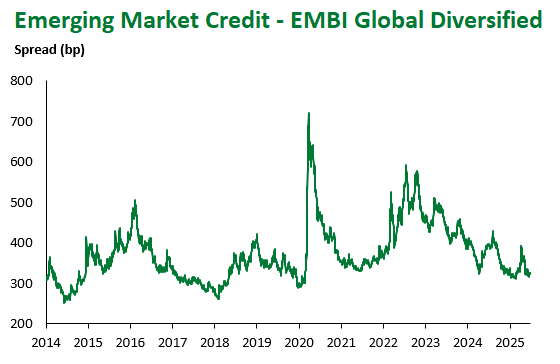
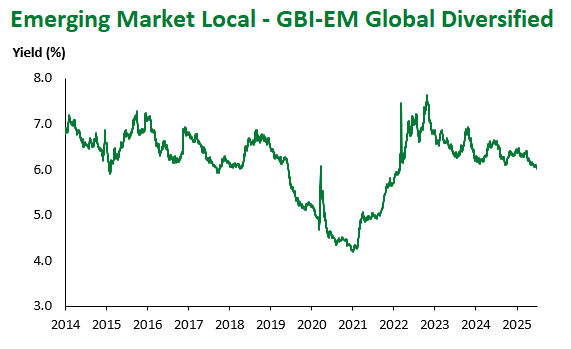
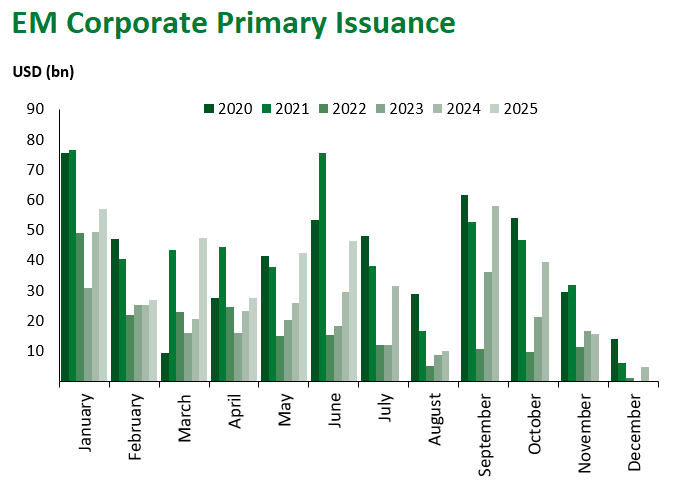
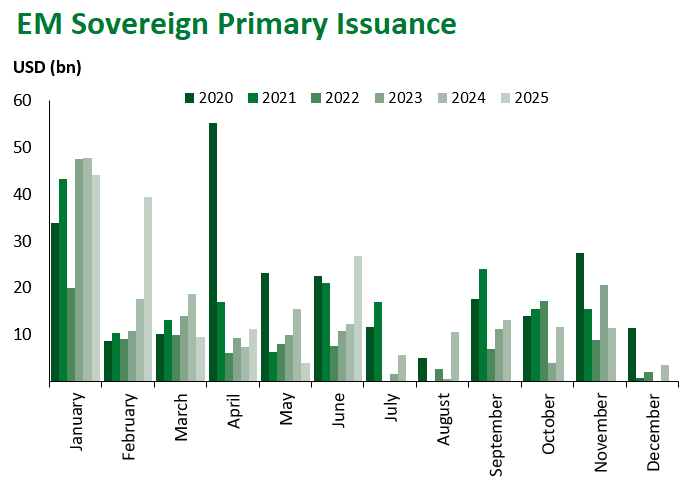
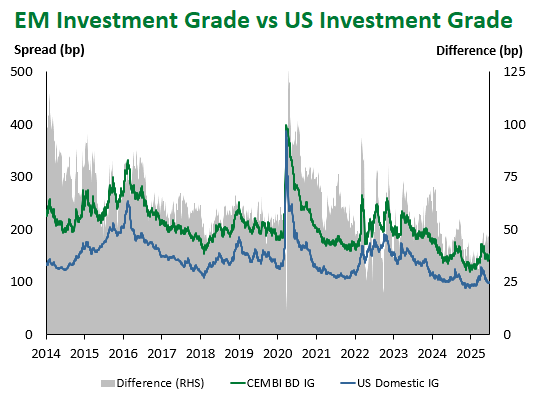

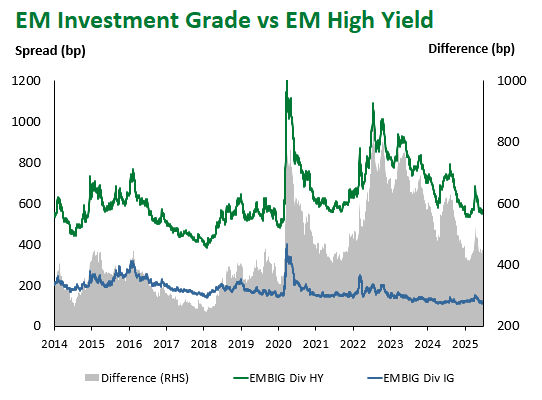
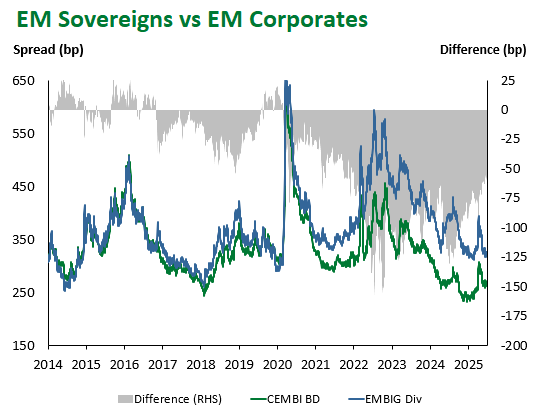
Emerging Markets Flows
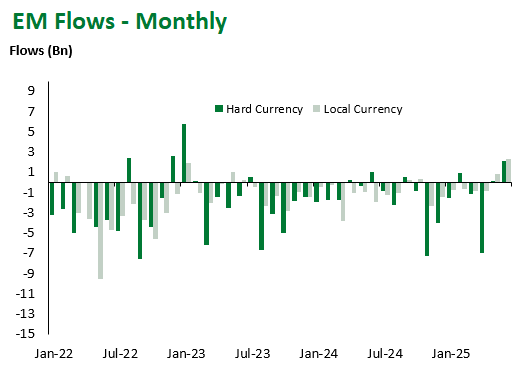
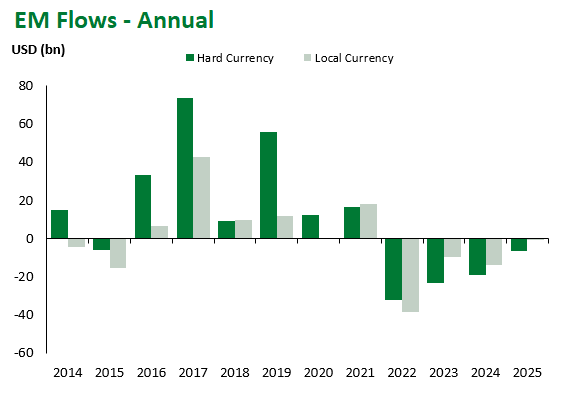
Source for graphs: Bloomberg, JPMorgan, Gramercy. As of June 27, 2025.
For questions, please contact:
Kathryn Exum, CFA ESG, Director, Co-Head of Sovereign Research, [email protected]
Petar Atanasov, Director, Co-Head of Sovereign Research, [email protected]
This document is for informational purposes only. The information presented is not intended to be relied upon as a forecast, research or investment advice, and is not a recommendation, offer or solicitation to buy or sell any securities or to adopt any investment strategy. Gramercy may have current investment positions in the securities or sovereigns mentioned above. The information and opinions contained in this paper are as of the date of initial publication, derived from proprietary and nonproprietary sources deemed by Gramercy to be reliable, are not necessarily all-inclusive and are not guaranteed as to accuracy. This paper may contain “forward-looking” information that is not purely historical in nature. Such information may include, among other things, projections and forecasts. There is no guarantee that any forecasts made will come to pass. Reliance upon information in this paper is at the sole discretion of the reader. You should not rely on this presentation as the basis upon which to make an investment decision. Investment involves risk. There can be no assurance that investment objectives will be achieved. Investors must be prepared to bear the risk of a total loss of their investment. These risks are often heightened for investments in emerging/developing markets or smaller capital markets. International investing involves risks, including risks related to foreign currency, limited liquidity, less government regulation, and the possibility of substantial volatility due to adverse political, economic or other developments. References to any indices are for informational and general comparative purposes only. The performance data of various indices mentioned in this update are updated and released on a periodic basis before finalization. The performance data of various indices presented herein was current as of the date of the presentation. Please refer to data returns of the separate indices if you desire additional or updated information. Indices are unmanaged, and their performance results do not reflect the impact of fees, expenses, or taxes that may be incurred through an investment with Gramercy. Returns for indices assume dividend reinvestment. An investment cannot be made directly in an index. Accordingly, comparing results shown to those of such indices may be of limited use. The information provided herein is neither tax nor legal advice. Investors should speak to their tax professional for specific information regarding their tax situation.
